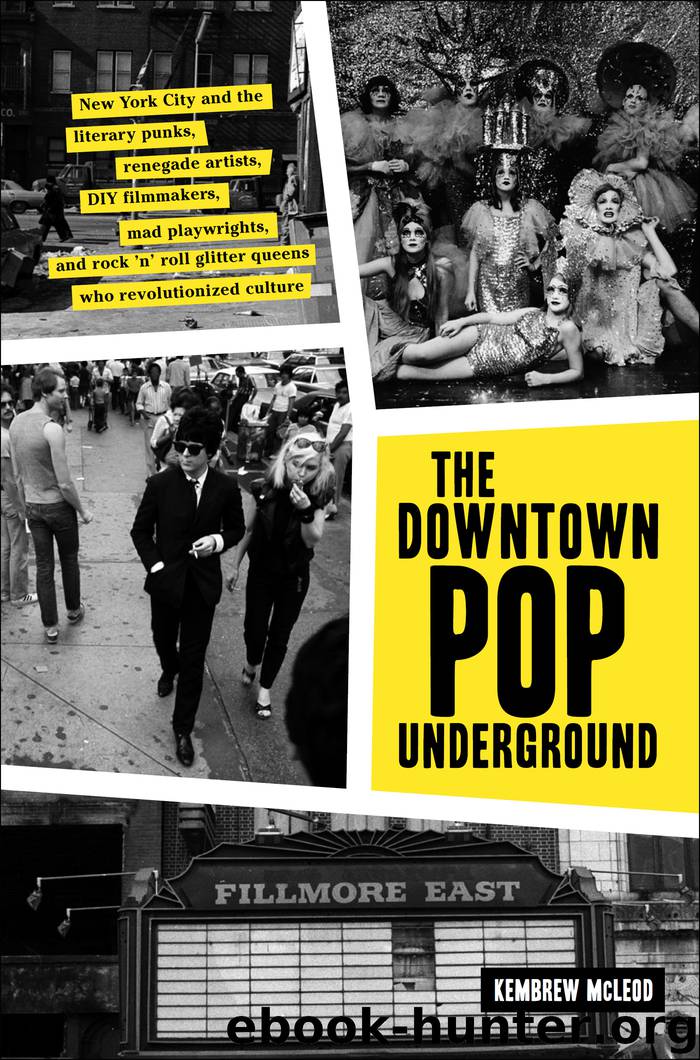The Downtown Pop Underground by Kembrew McLeod

Author:Kembrew McLeod
Language: eng
Format: epub
Publisher: Abrams
Published: 2018-11-17T16:00:00+00:00
CHAPTER 19
Darkness Descends on the East Village
Two blocks south of St. Mark’s Place, on Second Avenue and Sixth Street, was the Fillmore East. For a brief period between 1968 and 1971, it hosted everything from the Living Theatre and Paul Krassner’s stand-up comedy routines to the downtown sounds of the Fugs and Silver Apples, along with touring acts like the Who, Jefferson Airplane, and Jimi Hendrix. Before that time, the city had been devoid of large rock-friendly venues, and those who did promote rock music were ignorant about the underground scene. “They weren’t really a part of it, so they didn’t understand it,” Silver Apples’ Simeon Coxe said. “Finally, Bill Graham came up with the idea of opening the Fillmore East, which was a major part of the downtown rock scene in the late sixties and early seventies.”
Graham grew up in New York as a German Holocaust survivor and an aspiring actor, and after moving to San Francisco he found success as a live music promoter by opening the Fillmore Auditorium to capitalize on the city’s thriving psychedelic music scene. Lighting designer Joshua White recalled that Graham initially resisted the idea of running a New York venue, despite many overtures. White had been involved in booking rock acts that played in the old vaudeville theaters that lined Second Avenue, and he and others finally convinced the promoter to fly out to one of their sold-out shows. Graham heard the sound of ringing cash registers after he saw the full house, so White and others began working night and day to convert an old Yiddish auditorium into the Fillmore East.
Everyone who worked there came out of theater school—including White—and they also had the good luck of sharing a building wall with NYU’s Tisch School of the Arts. “Their students came over because rock ’n’ roll was exciting,” White said, “and many of them got involved in the Fillmore. So we began with this very high level of well-trained people.” White had studied lighting at film and theater school and worked at discothèques before his tenure at the Fillmore East. “Lighting was always a key interest in my life,” he continued, “but I didn’t know where to apply it.” White initially created lighting systems for discos such as Arthur, Salvation, and Trude Heller’s, where he began to develop techniques that he refined at the Fillmore East: color washes, lights mounted on motors that could rotate and reverse, and reflective objects that moved and bounced light in asymmetrical ways.
White had seen Warhol’s Exploding Plastic Inevitable, but he was much more impressed by what was happening in a venue that opened on St. Mark’s Place, in the basement space where the Dom had previously been located. “It was now remodeled as the Electric Circus,” White said. “Now, when you say remodel, what it really means is they put stretched nylon over the space inside, changing the space by throwing light all over the place. Even though it was just a ratty ballroom, it now
Download
This site does not store any files on its server. We only index and link to content provided by other sites. Please contact the content providers to delete copyright contents if any and email us, we'll remove relevant links or contents immediately.
Aircraft Design of WWII: A Sketchbook by Lockheed Aircraft Corporation(32192)
The Great Music City by Andrea Baker(31251)
Call Me by Your Name by André Aciman(20351)
The Secret History by Donna Tartt(18811)
The Art of Boudoir Photography: How to Create Stunning Photographs of Women by Christa Meola(18504)
Shoot Sexy by Ryan Armbrust(17637)
Plagued by Fire by Paul Hendrickson(17314)
Portrait Mastery in Black & White: Learn the Signature Style of a Legendary Photographer by Tim Kelly(16933)
Adobe Camera Raw For Digital Photographers Only by Rob Sheppard(16882)
Photographically Speaking: A Deeper Look at Creating Stronger Images (Eva Spring's Library) by David duChemin(16601)
Ready Player One by Cline Ernest(14496)
Pimp by Iceberg Slim(14323)
Bombshells: Glamour Girls of a Lifetime by Sullivan Steve(13953)
The Goal (Off-Campus #4) by Elle Kennedy(13477)
Art Nude Photography Explained: How to Photograph and Understand Great Art Nude Images by Simon Walden(12954)
Kathy Andrews Collection by Kathy Andrews(11709)
The Priory of the Orange Tree by Samantha Shannon(8862)
The remains of the day by Kazuo Ishiguro(8791)
Thirteen Reasons Why by Jay Asher(8767)
